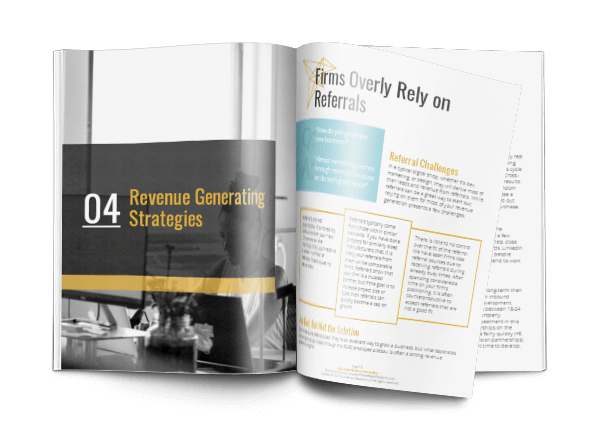Summary
Most firms employ multiple pricing methods with Hourly, Fixed bid, and Retainers being the most popular. Value based pricing is used by about a third of firms and Points based is rarely used. However, when the question is changed to ask “What is the most common way you price your services?” we see a significant decline in those using Value based and Retainer pricing with Hourly and Fixed fee making up 90% of the responses.
The most stable revenue growth came from firms employing Fixed bid and Retainer pricing, while the most variance came from those using Value based (excluding Points based). Pricing method did not appear to have any significant impact on profitability.
Prices are either set by a CEO / Owner (61% of the time) or by sales (32% of the time). Firms where pricing is set by sales teams tend to be larger than those where pricing is set by CEO / Owners.
Retainer pricing is seen as the most optimal while Points based is viewed least-favorably.
Just under half of firms surveyed have changed their pricing strategies due to the pandemic. Overall, we are seeing reductions in rates and a focus on more reliable cash flow from digital shops. The main ways firms have changed pricing are by reducing hourly rates, offering financing to clients, and reducing retainers.
Some of the largest challenges firms face revolve around client budget reductions, competition with other firms that have reduced rates, and shrinking profit margins.
Standard Pricing Methods
In order to understand how pricing is changing, we need to establish a baseline understanding of how digital shops price their services.
One of the core questions we asked was “How do you typically price your services?” There is a fair amount of debate in the industry over the proper way to price digital services so it is important to understand just how common various pricing methodologies are in the industry. When combining this with other survey data, we’re able to understand the efficacy of each pricing model. Here’s what we found:
Multi-Method Pricing Strategies
In order to understand just broadly digital shops are pricing their services, we asked survey participants to list all the ways they priced their services in 2019 and 2020.
We found that the vast majority of firms employ multiple pricing methodologies with Retainer, Hourly, and Fixed-bid pricing models dominating the landscape. Only about a third of firms employ Value based pricing at all and Points based pricing is almost nonexistent.
Most Common Pricing Methodology
While most firms employ multiple pricing methodologies, it’s important to understand how often they are used. We asked respondents in the third quarter of this year to select their most commonly employed pricing methodology.
We found that Hourly and Fixed fee methodologies were used almost exclusively and in similar proportions. While Value based pricing is employed by a bit over 1/3 of firms, it is only used as the primary pricing method 7% of the time.
Pricing Methodology Impact
Just how much do different pricing methodologies impact growth and profitability? This was the next question we dug into. In these surveys we asked for growth rates and profit margins. We then calculated average growth rates and profit margins for each of the pricing methods.
Firms that employed Fixed bid and Retainer pricing methods tended to have the most stable revenue growth. Excluding those that used Points based pricing (low responses and high variance), those that employed Value based pricing saw the most significant fluctuations in their annual growth rates.
All pricing models, excluding Points based, produced similar profit margins.
Price Setting
Just over half of respondents indicated the CEO is responsible for setting pricing and only about a third reported that Sales managed the firm’s pricing. As firm size increased, it was more likely that Sales would be responsible for setting prices vs the CEO.
While not surprising, this finding furthers our belief that building sales teams that are capable of managing the entire sales process (including pricing) is a cornerstone to successfully growing a digital shop.
In a standard shop of 25 employees, revenue generation duties are typically managed by a CEO or partner, and in some occasions, a dedicated salesperson. See our guide to Repeatable Revenue Generation for more.
The Optimal Pricing Method
So what is the best way to price digital services? We asked owners this exact question.
Seeing such a strong preference for Retainer-based work makes sense if we look at it through the “recurring revenue = safe revenue” lens. While this method provides the slowest growth, it is also the safest from a cashflow perspective.
Value-based pricing came in at 29% of responses, which is slightly lower than the number of firms employing this methodology, but significantly higher than the percent of firms employing this method most commonly. This indicates a disconnect between those who primarily employ Value based pricing (7% of firms) and those who believe it is the optimal method (29% of firms).
Changes Due to the Pandemic
Now that we have a fairly comprehensive understanding of how firms typically price their services, we can dive into the changes they have implemented since the pandemic began.
Have Firms Changed Their Pricing?
Just under half of the firms in our quick-check survey changed their pricing strategy in the last few months due to the pandemic. Larger firms were slightly more likely to have changed pricing compared to smaller firms.
A potential concern here lies in how firms modified their pricing. Reducing prices, either by lowering/suspending down payments, dropping hourly rates, or reducing project rates, can have lasing consequences. Raising prices back to normal is challenging even during a good economy. A tactic we have seen successfully employed by multiple shops is keeping pricing firm, but breaking projects into multiple smaller ones. If you must reduce prices, be sure to clearly communicate to clients and prospects that these reductions are temporary.
%
Changed pricing
Average Blended Hourly Rate
How Firms Are Changing Their Pricing
Overall, we are seeing reductions in rates and a focus on more reliable cash flow from digital shops.
Firms have reported reducing hourly rates by 10-25% to help fill pipelines. Some have begun to essentially offer financing for clients by structuring payment plans for new projects. While firms are placing a stronger focus on Retainer work, they are dropping average retainer values.
Some firms have begun to itemize more of their invoices to better communicate the value they are delivering to clients. Other firms are offering discounts on projects for longer-term engagements or for closing more quickly.
REDUCING HOURLY RATES
OFFERING FINANCING
REDUCING RETAINERS
ITEMIZING INVOICES
DISCOUNTS FOR LONG-TERM ENGAGEMENTS
DISCOUNTS FOR CLOSING MORE QUICKLY
Pandemic Pricing Challenges
Respondents were asked about the major challenges they are facing with respect to pricing. These are their key areas of concern:
“Client budgetary cutbacks and more stringent project limitations”
“An increase in clients hiring lower-cost freelancers instead of full-service shops”
“Increasing staff seniority putting upward pressure on costs contrasting with downward price pressure from the overall market”
“Accurate project estimation for fixed-bid projects”
“Competing with other firms that are dropping rates”
“Reducing rates and sacrificing profit margins”
Responses & Demographics
The goal of this report is to understand if and how digital shops are changing their pricing models in light of the pandemic.
Our research has covered over 1,000 digital service and marketing firms. That research is comprised of our primary survey and interview work with owners and managers of digital shops in North America and Europe. For this report, we are aggregating data from two annual outlook surveys, completed in 1Q19 and 1Q20 and a quick-check survey completed in 3Q20. Together these surveys represent the pricing of 306 firms. The 1Q19 survey had 169 participants, the 1Q20 survey had 107 participants, and the quick-check 3Q20 survey had 31 participants.
Our surveys cover a range of company sizes, with Small (10-24 employees) being the most commonly represented at ~46% of responses, followed by Studio (<10 employees) making up 27%, Medium (25-49 employees) at 18%, and finally Large (>=50 employees) at 8%. This size distribution compares favorably to our high-level view of how digital shops are distributed with respect to employee counts (see firm size distribution in our Digital Marketing Industry Report).





